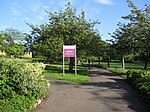Fairfield (Croydon ward)

Fairfield is a ward in the London Borough of Croydon, covering most of the Croydon area of London in the United Kingdom. The ward currently forms part of the Croydon Central parliamentary constituency, except for a small area near West Croydon station which is part of the Croydon North constituency. The population of the ward at the 2011 Census was 16,569.The ward returns three councillors every four years. At the 2006 Croydon Council election, David Fitze, Vidhi Mohan and Sue Winborn were elected to the council. All of them stood as Conservative Party candidates. The turnout in the ward was similar to others in the area. Fairfield contains Croydon town centre, with its retail and office core. Until 2018, it also contained Park Hill and the Whitgift Estate to the east which is mostly 20th century housing bordering Lloyd Park. These became a separate Park Hill and Whitgift ward in 2018, leading to the Fairfield ward now having a radically different character to before. Also found in the ward are Ruskin House, the headquarters of the Croydon Labour Party, and the Fairfield Halls concert hall and arts centre. The Vanguard Way passes along the Fairfield Path.
Excerpt from the Wikipedia article Fairfield (Croydon ward) (License: CC BY-SA 3.0, Authors, Images).Fairfield (Croydon ward)
Pageant Walk, London Addiscombe (London Borough of Croydon)
Geographical coordinates (GPS) Address Nearby Places Show on map
Geographical coordinates (GPS)
| Latitude | Longitude |
|---|---|
| N 51.3709 ° | E -0.0875 ° |
Address
Pageant Walk
Pageant Walk
CR0 5UG London, Addiscombe (London Borough of Croydon)
England, United Kingdom
Open on Google Maps










